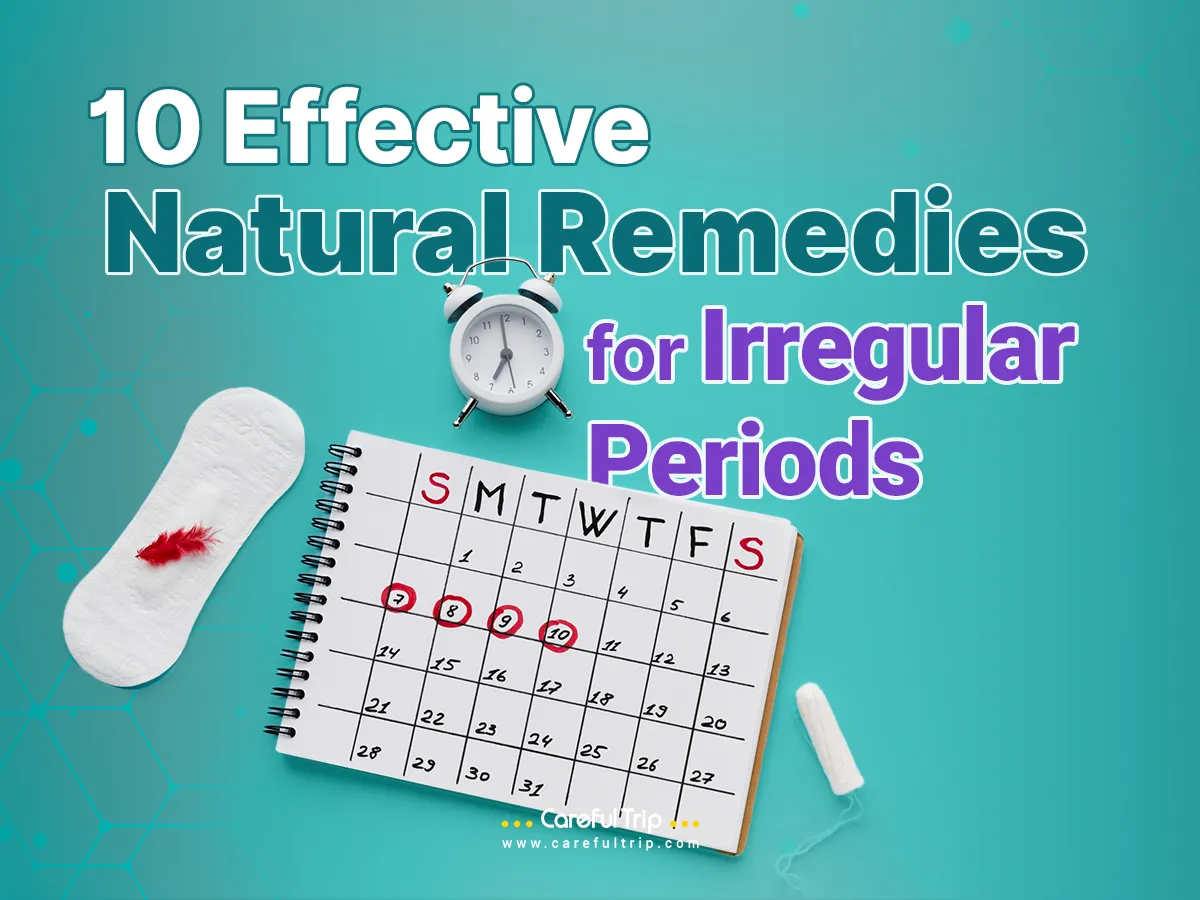
Irregular periods are more than just a monthly inconvenience. They can signal deeper issues, such as hormonal imbalances, metabolic dysfunctions, chronic stress, or underlying reproductive conditions like PCOS or thyroid disorders. In many cultures, including in Iran and across the Middle East, natural remedies for menstrual regulation are both historically rooted and scientifically validated.
Here, we examine the biology of menstruation, identify the causes and types of irregular periods, and present ten in-depth natural remedies, supported by research, clinical trials, and traditional medicine, to help restore menstrual health. Whether you’re seeking alternative therapies, complementary treatments, or holistic lifestyle adjustments, this article serves as a detailed resource.
Understanding the Menstrual Cycle
The menstrual cycle is orchestrated by a complex hormonal loop known as the hypothalamic-pituitary-ovarian (HPO) axis. A typical cycle lasts between 21 to 35 days, with ovulation occurring around day 14 in a 28-day cycle.
The key hormonal phases include:
- Menstrual phase (Days 1–5): Shedding of the uterine lining begins if fertilization didn’t occur.
- Follicular phase (Days 1–14): FSH stimulates the ovaries to produce follicles. One becomes dominant.
- Ovulation (Day 14): A spike in LH causes the dominant follicle to release an egg.
- Luteal phase (Days 15–28): Progesterone from the corpus luteum thickens the uterine lining.
Disruptions at any stage can lead to irregular periods — skipped cycles, excessive bleeding, or infrequent menstruation.
What Is Considered an Irregular Period?
Menstrual irregularities are categorized into several types:
- Oligomenorrhea: Cycles longer than 35 days
- Polymenorrhea: Cycles shorter than 21 days
- Amenorrhea: No menstruation for 3+ months (excluding pregnancy or menopause)
- Menorrhagia: Excessively heavy bleeding
- Metrorrhagia: Bleeding between periods
Occasional irregularities are common, but persistent changes often indicate a deeper issue.
Root Causes of Irregular Periods
Irregular periods can stem from:
- Polycystic Ovary Syndrome (PCOS): Characterized by hyperandrogenism, anovulation, and insulin resistance.
- Thyroid disorders: Hypothyroidism and hyperthyroidism disrupt cycle length and ovulation.
- Extreme weight changes: Body fat directly influences estrogen production.
- Chronic stress: Affects hypothalamic hormone regulation (GnRH), delaying ovulation.
- Perimenopause: Hormonal fluctuations in the years before menopause.
- Diabetes and insulin resistance: Especially relevant in PCOS patients.
- Intensive exercise and eating disorders: Low energy availability suppresses the HPO axis.
The 10 Most Effective Natural Remedies for Irregular Periods
Here, we break down ten remedies that are not only culturally respected but also evidence-based, integrating modern science with traditional wisdom.
1. Weight Regulation (Loss or Gain)
Adipose tissue plays a crucial role in estrogen regulation. Both obesity and underweight status can lead to anovulation.
- In PCOS, Losing 5–10% of body weight can restore ovulatory cycles (ACOG, 2021).
- In athletes or individuals with low BMI: Gaining body fat helps normalize leptin and restore menstruation.
2. Balanced, Low-Glycemic Diet
Diets high in processed carbohydrates can exacerbate insulin resistance and androgen excess in PCOS. A low-glycemic diet rich in whole foods supports metabolic and hormonal balance.
Best foods for menstrual balance:
- Legumes
- Whole grains (barley, oats, brown rice)
- Leafy greens and cruciferous vegetables
- Omega-3 rich sources (flaxseed, walnuts, fish)
Study: A 2020 meta-analysis found the Mediterranean diet improved ovulatory frequency in PCOS (Nutrients, 2020).
3. Cinnamon Extract
Cinnamon improves insulin sensitivity and blood flow — key benefits for women with PCOS.
Dosage: 1.5–2 grams/day (capsules, powder, or tea)
Evidence: A 2014 double-blind RCT confirmed its role in regulating cycles in PCOS (PubMed: 24813595).
4. Ginger Root
Ginger has long been used in Persian and Chinese medicine for menstrual complaints. It improves circulation and reduces prostaglandins, which cause pain and irregular bleeding.
Dosage: 750–2,000 mg/day
Clinical data: Ginger reduced excessive bleeding and dysmenorrhea in a randomized study published in Phytotherapy Research (PMC4758348).
5. Vitamin D and B12
Low Vitamin D levels are common in women with PCOS and amenorrhea. B12 supports red blood cell production and estrogen metabolism.
- Vitamin D3: 2,000 IU/day
- Vitamin B12 (methylcobalamin): 500 mcg/day
Study: Supplementing Vitamin D restored menstruation in 30% of women with secondary amenorrhea (PMC6616870).
6. Stress Reduction Techniques
Psychological stress interferes with the HPO axis and elevates cortisol, which suppresses reproductive hormones.
Evidence-based techniques:
- Mindfulness meditation
- Yoga (especially restorative and yin)
- Breathwork (e.g., box breathing)
- Cognitive Behavioral Therapy (CBT)
Study: A 2019 review linked stress management to improved luteal phase duration and ovulatory consistency (Medical News Today, 2020).
7. Sleep and Circadian Rhythm Management
Melatonin and reproductive hormones are tightly connected. Shift work and poor sleep can trigger cycle irregularities.
Tips for hormonal sleep hygiene:
- Sleep at consistent times
- Block blue light exposure before bed
- Avoid caffeine after 2 PM
Evidence: Shift workers reported twice the rate of menstrual disturbances (PubMed: 26611989).
8. Moderate Physical Activity
Exercise enhances insulin sensitivity and endorphin release. But too much exercise can shut down menstruation.
Optimal strategy:
- 3–5x/week, 30–60 minutes
- Include strength training and yoga
- Avoid overtraining and under-fueling
9. Pineapple (Bromelain Enzyme)
Pineapple contains bromelain, which may reduce inflammation and support endometrial health. Though lacking strong clinical trials, it’s widely used in traditional fertility diets.
How to use it:
- Eat fresh pineapple core during the luteal phase
- Avoid canned varieties (bromelain is heat-sensitive)
10. Herbal Remedies: Vitex (Chasteberry)
Vitex agnus-castus supports progesterone production and can help normalize luteal phase defects.
Dosage: 20–40 mg/day, standardized extract
Study: A clinical trial found Vitex improved cycle regularity and fertility outcomes in women with luteal phase defects (PubMed, 2016).
Cultural Insight: Natural Menstrual Regulation in Iran
Iranian traditional medicine (ITM), rooted in Avicenna’s teachings, often employs warming herbs like cinnamon, ginger, and saffron for regulating female reproductive health. Infusions made with borage, fennel, or chamomile are still popular remedies passed through generations. These align with modern evidence supporting their anti-inflammatory, antispasmodic, and hormonal-modulating effects.
Clinics such as MOM Fertility Center in Tehran now integrate nutritional counseling and herbal support into fertility programs for irregular cycles, offering a culturally resonant, holistic approach.
When to See a Fertility Specialist
While natural remedies can be highly effective, they are not substitutes for medical evaluation when deeper issues exist.
Seek help if:
- No menstruation for more than 90 days
- Sudden changes in cycle length or heaviness
- Trying to conceive for over 12 months without success
- Experiencing pain, hirsutism, or acne (possible PCOS)
Final Thoughts
Irregular periods are not merely inconvenient — they are often signals of deeper systemic imbalances. Through a combination of nutrition, lifestyle changes, herbal medicine, and mind-body practices, many women can restore their cycles without pharmaceuticals. However, a personalized approach — ideally one that combines natural remedies with diagnostic medical support — offers the most effective path.
If you are based in or considering treatment in Iran, consult clinics like MOM Fertility Center or agencies like CarefulTrip that specialize in integrative fertility solutions.
References
-
- PubMed. (2014). Cinnamon Improves Menstrual Cyclicity in Women With Polycystic Ovary Syndrome. https://pubmed.ncbi.nlm.nih.gov/24813595/
- NIH. (2020). The Effect of Mediterranean Diet on PCOS. https://www.ncbi.nlm.nih.gov/pmc/articles/PMC7417306/
- NIH. (2019). Vitamin D and Menstrual Cycle Regularity. https://www.ncbi.nlm.nih.gov/pmc/articles/PMC6616870/
- NIH. (2016). Ginger and Menstrual Bleeding. https://www.ncbi.nlm.nih.gov/pmc/articles/PMC4758348/
- PubMed. (2016). Shift Work and Menstrual Disturbance. https://pubmed.ncbi.nlm.nih.gov/26611989/
- Medical News Today. (2020). Stress and Menstrual Health. https://www.medicalnewstoday.com/articles/324781
- ACOG. (2021). Polycystic Ovary Syndrome (PCOS). https://www.acog.org/womens-health/faqs/polycystic-ovary-syndrome-pcos
- PubMed. (2016). Effect of Vitex agnus-castus on Luteal Phase Defect. https://pubmed.ncbi.nlm.nih.gov/27022229/
